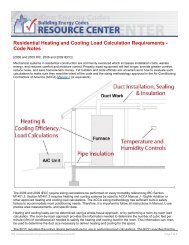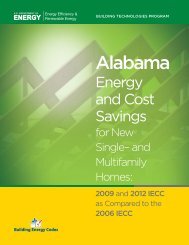This study selects <strong>the</strong> midpo<strong>in</strong>t score levels for comparison (specifically, <strong>the</strong>second score level for roofs and walls, and <strong>the</strong> fourth to sixth levels forw<strong>in</strong>dows). 30 Japan’s build<strong>in</strong>g energy codes place heavy emphasis on SHGC. Forexample, <strong>the</strong> highest score for SHGC is 90 (for most of Japan), 50 (<strong>in</strong> <strong>the</strong> coldzone), and 170 (<strong>in</strong> <strong>the</strong> tropical zone), while <strong>the</strong> highest score for U-factors ofwalls and w<strong>in</strong>dows, respectively, is 30.South Korea also uses a po<strong>in</strong>t system to measure build<strong>in</strong>g performance <strong>in</strong> <strong>the</strong>BDCES. The m<strong>in</strong>imum score should be 60 for <strong>the</strong> whole build<strong>in</strong>g (<strong>in</strong>clud<strong>in</strong>gconstruction and mechanical and electronic design criteria). For <strong>the</strong> build<strong>in</strong>genvelope, <strong>the</strong>re are five levels of <strong>the</strong>rmal requirements. South Korea providesm<strong>in</strong>imum R-value by region for roofs, walls and floors for all build<strong>in</strong>gs. For <strong>the</strong>envelope of large build<strong>in</strong>g, <strong>the</strong>re are five levels of <strong>the</strong>rmal requirements (overallenvelope U-value) that are calculated by averag<strong>in</strong>g <strong>the</strong> U-value both w<strong>in</strong>dow andwall which varies depend<strong>in</strong>g on w<strong>in</strong>dow to wall ratio. The RBFCO providesadditional prescriptive requirements for <strong>in</strong>sulation; <strong>the</strong> envelope analysis relies on<strong>the</strong> RBFCO requirements. The maximum U-factors <strong>in</strong> <strong>the</strong> United States commercial build<strong>in</strong>g energy codesare categorized by build<strong>in</strong>g materials. U-factor and SHGC are two <strong>in</strong>dicators forw<strong>in</strong>dow <strong>the</strong>rmal <strong>in</strong>sulation.Four countries have jurisdictions <strong>in</strong> <strong>the</strong> hot climate zone <strong>in</strong>clud<strong>in</strong>g Australia, Ch<strong>in</strong>a, India,and <strong>the</strong> United States. In this zone, Australia has <strong>the</strong> most str<strong>in</strong>gent requirements forroofs and floors, while India has <strong>the</strong> most str<strong>in</strong>gent requirements for walls. The UnitedStates has comparatively str<strong>in</strong>gent requirements for roofs and solar heat ga<strong>in</strong> coefficient<strong>in</strong> w<strong>in</strong>dows. It has a wide range of requirements for walls, and <strong>the</strong> least str<strong>in</strong>gentrequirements for floors. Ch<strong>in</strong>a has relatively weak requirements <strong>in</strong> all categories, but it isnot <strong>the</strong> least str<strong>in</strong>gent <strong>in</strong> any s<strong>in</strong>gle category. Figure 1 shows a comparison of <strong>the</strong> roofrequirements <strong>in</strong> this zone, while Table 10 provides a more comprehensive comparison ofall <strong>the</strong> key envelope requirements <strong>in</strong> this zone. Each of <strong>the</strong> comparative tables <strong>in</strong> thissection highlight one country under each component. This is <strong>the</strong> country that has <strong>the</strong> moststr<strong>in</strong>gent requirements (for <strong>the</strong> majority of its commercial build<strong>in</strong>gs) <strong>in</strong> a given category.Several factors can affect <strong>the</strong> str<strong>in</strong>gency of envelope requirements <strong>in</strong> different countries.<strong>Energy</strong> prices vary among countries. Most countries conduct cost-benefit analyses of <strong>the</strong>requirements before adopt<strong>in</strong>g <strong>the</strong>m; differences <strong>in</strong> energy prices can lead to differentrecommendations on cost-effective requirements. Stakeholders can also play an importantrole, particularly <strong>in</strong> countries that use some type of stakeholder process or allow publiccomment before revis<strong>in</strong>g <strong>the</strong>ir standards. Insulation manufacturers may play aparticularly active role <strong>in</strong> one country, while w<strong>in</strong>dows manufacturers may be moreprom<strong>in</strong>ent <strong>in</strong> ano<strong>the</strong>r. In some cases, if an <strong>in</strong>dustry like <strong>in</strong>sulation is less vocal, it mayalso <strong>in</strong>dicate that <strong>the</strong>re are few products available on <strong>the</strong> local market. The productsavailable and <strong>the</strong> role of <strong>in</strong>dustry can thus affect <strong>the</strong> requirements adopted.30 We selected <strong>the</strong> midpo<strong>in</strong>t levels <strong>in</strong>stead of <strong>the</strong> maximum U-factors because Japan’s commercial code hasno maximum <strong>in</strong> most categories. In addition, s<strong>in</strong>ce Japan does not have prescriptive commercialrequirements – only trade-off ones – it was important to pick numbers that would lead to a build<strong>in</strong>g thatcomplied, but did significantly exceed <strong>the</strong> compliance level <strong>in</strong> order to provide a good po<strong>in</strong>t of comparison.38
Figure 1 Comparison of Roof U-factor Requirements <strong>in</strong> <strong>the</strong> Hot Zone1.210.8U-factor0.6Roof (Low)Roof (High)Midpo<strong>in</strong>t0.40.20Ha<strong>in</strong>an, CHN(Residential)Ha<strong>in</strong>an, CHN(Commercial)Miami, USA <strong>New</strong> Delhi, IND Darw<strong>in</strong>, AUSTable 11 Thermal Characteristics of Roofs, Walls, Floors and W<strong>in</strong>dows <strong>in</strong> <strong>the</strong> Hot ZoneMaximum U-factors W/(m²·K)W<strong>in</strong>dow IndicatorsCitiesSuspendedRoof External WallFloorAggregate conductance factorDarw<strong>in</strong>0.31 0.56 0.67 not directly comparable with u-AUSfactors 31Ha<strong>in</strong>anCHN<strong>New</strong> DelhiIND0.90 1.50 1.50Heavyconstruction:1.0, lightconstruction:0.50.41(O<strong>the</strong>rs)0.26 (24-hourbuild<strong>in</strong>gs),Heavyconstruction:1.0to 2.0N.A.0.41 N.A.Maximum U-factor: 3.0 to 6.5by WWR; shad<strong>in</strong>g coefficient,SC (east, south and west /north): 0.50/0.60 to 0.35/0.45by WWRMaximum U-factor: 2.00 to6.50 by WWR and outdoorconditionsMaximum U-factor is 3.30, andmaximum SHGC is 0.20 to0.2531RE Horne (2005) International comparison of build<strong>in</strong>g energy performance standards.39
- Page 1 and 2: PNNL-122267Shaping the Energy Effic
- Page 3: Shaping the Energy Efficiency in Ne
- Page 6 and 7: efficient air conditioning system,
- Page 8 and 9: ContentsForeword ..................
- Page 10 and 11: List of TablesTable 1 GDP, Primary
- Page 12 and 13: ForewordBuildings account for about
- Page 14 and 15: 1 Introduction and Background1.1 Im
- Page 16 and 17: esidential buildings in 2006, with
- Page 18 and 19: JAP 1. Criteria for Clients on the
- Page 20 and 21: can significantly increase energy d
- Page 22 and 23: f) South Korea’s building energy
- Page 24 and 25: 2.1 AustraliaIn the past, Australia
- Page 26 and 27: small cities will be pilot of such
- Page 28 and 29: (DCGREUH) issued by the Ministry of
- Page 30 and 31: according to the current codes. Thi
- Page 32 and 33: Table 7 Structural Comparison of Bu
- Page 34 and 35: 3.3 Building EnvelopeKey Findings A
- Page 36 and 37: JAPCCREUH1999KORBDCES2008USAASHRAE9
- Page 40 and 41: MiamiUSA0.36(Insulationabove deck)t
- Page 42 and 43: Six countries have jurisdictions in
- Page 44 and 45: thermal requirements for roofs, flo
- Page 46 and 47: Figure 6 Maximum U-factors in Resid
- Page 48 and 49: Table 16 HVAC in Japan’s Building
- Page 50 and 51: ItemsService water heating refers t
- Page 52 and 53: Water conservation Canada has manda
- Page 54 and 55: practice (MNECB 1997). India sets m
- Page 56 and 57: Canada and India adopt compliance p
- Page 58 and 59: Japan only supervises the building
- Page 60 and 61: 4.2 Testing and RatingKey Findings
- Page 62 and 63: Other commonly used tools among APP
- Page 64 and 65: CAN 55MNECH1997CHNINDECBCJAPCanadia
- Page 66 and 67: and local jurisdiction contact info
- Page 68 and 69: certifying third-party verifiers or
- Page 70 and 71: Point of ControlIncentives for Comp
- Page 72 and 73: Point of ControlIncentives for Comp
- Page 74 and 75: AUS,continuedCANTesting Agencies an
- Page 76 and 77: CAN,continuedCHNTesting Agencies an
- Page 78 and 79: Testing Agencies and Certification
- Page 80 and 81: USA,continuedTesting Agencies and C
- Page 82 and 83: Appendix C - Compliance SoftwareAUS
- Page 84 and 85: CANMNECB1997,continuedSoftwareMetho
- Page 86 and 87: USAIECC 2006,continuedSoftwareMetho
- Page 88 and 89:
AUSBCA 2007,continuedCANMNECB1997CA
- Page 90 and 91:
JAP,ContinuedKORUSAASHRAE90.1-2007T
- Page 92 and 93:
AcronymsAPPAS/NZSASHRAEAUSBATFBCABD
- Page 94 and 95:
ReferencesABCB (Australian Building
- Page 96 and 97:
IEA (International Energy Agency).
- Page 98:
OEE. 2008. Energy Use Data Handbook
















